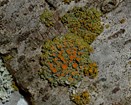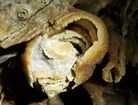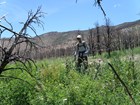The Midden is the Resource Management Newsletter of Great Basin National Park, published each summer and winter. Find out the latest going on at Great Basin National Park, Nevada in resource management and research. The Midden - Great Basin National Park: Vol. 19, No. 1, Summer 2019
-
Great Basin National Park
Article 1: Lichen Diversity in Great Basin National Park

When a lichen that had been known only from Antarctica and the High Arctic, Lecidea andersonii, turned up in collections made in Great Basin National Park during a BioBlitz in 2017, it became clear how little is known about lichen diversity and distributions in the Great Basin. Read more
-
Great Basin National Park
Article 2: SNPLMA-Funded Strawberry Creek Restoration Project Complete
The Southern Nevada Public Lands Management Act (SNPLMA)-funded Strawberry Creek Fuels Reduction and Sagebrush Steppe/Aspen Restoration project has come to a close. Initiated in 2015, this fuels reduction and habitat restoration project included 206 acres of Strawberry Creek. Read more
-
Great Basin National Park
Article 3: 2019 Snow Survey Results

After a few dry years, we were excited to see the mountains looking very white this winter. Just how much snow was up there? Park staff and volunteers skied up Baker Creek to measure the snow at three snow courses, at elevations of 8,200, 9,200, and 9,550 feet. Read more
-
Great Basin National Park
Article 4: Don’t Move Firewood
Why is moving firewood something we should think about? The answer is pretty straightforward: Movement of logs and firewood can transport tree-killing insects and diseases. Insects and disease agents are small, unable to move long distances on their own, and oftentimes go unnoticed because of where they live - underneath bark and within trunks or branches. Read more
-
Great Basin National Park
Article 5: GLORIA 2019 Update
GLORIA (Global Observation Research Initiative in Alpine Environments) is a collaborative network with a shared methodology for surveying alpine summits across the globe. The main objective of GLORIA is to assess global distributional shifts of alpine species in response to climate changes. It is a tremendous effort with over 100 alpine areas in the global network. Read more
-
Great Basin National Park
Article 6: Lehman Caves Geology Part III

The following article is excerpted from a paper I prepared for the Great Basin National Park staff on the Geologic Story of Lehman Caves. In the last two issues, I wrote about Stage 1, the Sulfide-rich, Hypogenic Speleogenesis time and Stage 2, Secondary Deposits and Finding Stability in a New Environment. In this issue, I talk about Stages 3, Calcite Speleothems and the Pleistocene, and 4, Condensation-Corrosion Speleogenesis. Read more
-
Great Basin National Park
Article 7: Night Sky Assessment Shows More Light from Ely

On September 10, 2018 the Natural Sounds and Night Skies coordinator for the Pacific West Region, Ashley Pipkin, took a night sky assessment at Great Basin NP. Read more
-
Great Basin National Park
Article 8: What Happens to Small Mammals with More Trees?
Meg Horner (NPS Biologist) and I recently published a peer-reviewed paper in Rangeland Ecology and Management. Read more
-
Great Basin National Park
Article 9: Citizen Science in Action

Would you like to learn more about the nature around you? Or record what you see in Great Basin? Or perhaps help your teenager connect technology with nature? Read more



